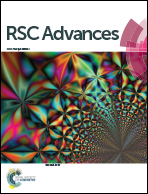Preparation and electrochemical characteristics of electrospun water-soluble resorcinol/phenol-formaldehyde resin-based carbon nanofibers†
Abstract
A series of flexible and free-standing carbon nanofiber mats derived from water-soluble resorcinol/phenol-formaldehyde resin/polyvinyl alcohol blend solution containing KOH were prepared by combining electrospinning and one-step carbonization/activation for the first time. Resultant porous carbon nanofibers have high specific surface area with large fraction of micropores ranging from 0.6 to 1.2 nm. The pore structure and chemical properties could be easily tuned by adjusting the amount of KOH. These carbon materials were studied as free-standing electrodes for supercapacitance eliminating the need for binding agents and conductive additives. The harshest activated sample with medium specific surface area (1169 m2 g−1) exhibited the largest specific capacitance of up to 332 F g−1 and the highest energy density about 37.6 W h kg−1 at 0.1 A g−1, about 59% higher than those of the sample without activation (209 F g−1, 23.6 W h kg−1 at 0.1 A g−1). Furthermore, the specific capacitance could still remain 221 F g−1 at 20 A g−1 with the retention of 67%. The sample also showed excellent cycle stability with 95% capacity retention after 3000 cycles. The outstanding performance of activated porous carbon nanofibers could be attributed to the synergistic effect of the proper pore size distribution, high effective surface area and reasonable amount of oxygen-containing functional groups, resulting in both electrochemical double layer and faradaic capacitance contributions.


 Please wait while we load your content...
Please wait while we load your content...